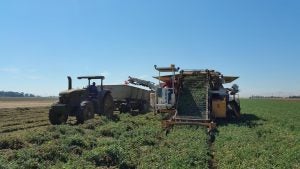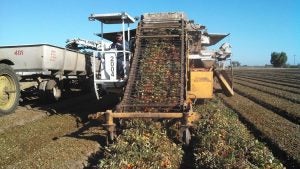It’s safe to say that California is a particularly interesting state in terms of agricultural production. From the massive dairy farms to the “salad bowl capital of the world” in Salinas, one would be hard pressed to miss out on diversity in the fresh fruit and veggie arena. But there is one crop I got to learn a lot about recently: tomatoes. And that meant spending time in the tomato fields near the Stockton, California, delta region.
David Yrigoyen farms nearby in Manteca and has been in the tomato business for around 40 years. He’s the father to Garrett Yrigoyen, fiancé to and winner of Becca’s season of the hit ABC TV show, “The Bachelorette.” While their family’s agricultural tomato transplanting business was showcased on the air, the real “show” is the beauty found amid the California tomato fields.

Tomatoes at this commercial operation are planted beginning in March and harvested between the Fourth of July and October, with a 120-day growing season and 24/7 harvesting. Farmers in his area typically contract with companies in June so they have a place to sell the crop. Each acre grows between 7,200 to 8,000 plants and yields around 50 to 55 tons — the farmer typically gets paid around $80 a ton. In this particular area of California, land values have skyrocketed, and it costs roughly $3,600 or $3,700 an acre to grow a crop, but yields tend to be higher. Growers shoot to sell one acre’s worth of crops for around $4,000 to bring a profit, but water and labor regulations continue to become more strict while operating expenses also continue to rise.
Of course, this varies. Regulations across state lines differ, and there are numerous variables and varieties of tomatoes for fresh market vs. canned, ketchup, and other processed products. This is what Yrigoyen grows: very ripe, acidic, juicy and flavorful tomatoes that are processed. Ever notice how fresh market tomatoes tend to not be as flavorful as the ones you grow in your backyard garden? It’s because they’re harvested before they’re totally ripe, and they’re a different variety that packs and ships well. Could you imagine what would happen if the tomatoes you bought in the store were bruised, damaged, diseased, and had a short shelf life? This is why varieties are chosen and harvested when they’re more resistant to the elements.
Yrigoyen has experience growing fresh market, organic, processed, all other types of tomatoes! He also grows alfalfa and used to have quite the diversified farm as a third-generation farmer. Over time, however, he (somewhat accidentally) found a niche with tomato transplanting as the most profitable part of his business and found his calling.
He’s in the right part of the country for so much tomato farming innovation and advancements.
UC-Davis invented the first tomato harvester, and like other aspects of agriculture, mechanization exploded over time. In the 1980s, tomatoes were planted directly in the soil from seed, but Yrigoyen discovered problems with tomato fields that were deserving of a solution — he wanted to think outside the box. The crop was ripening unevenly, and it required a lot of hoeing, physical labor, and cultivation to maintain. So, with 40 acres in 1986, he transplanted tomatoes to his fields from the nursery when the plants were around 6 inches tall.
The results were incredible! His neighbors wanted in. Yrigoyen started with two planters in the ’80s … then four, six, 17, and now has close to 20 tomato planters. Yrigoyen also designs, builds, and ships his custom tomato planters all over the world, and he plants for local growers in his area. The benefits of tomato transplanting are that it cuts down on pesticide use since the plants are already established, it reduces amount of physical labor when it can be hard to find good help, and it creates growing and harvesting uniformity. The list goes on.
Farmers generally tend to rotate crops year after year to break up pest pressures and put different nutrients back in the soil. Around here it’s not uncommon to rotate tomatoes with lima beans, black eyed peas, and red and kidney beans. Speaking of pests, farmers must manage weeds, insects, and disease, so they might use one application of pre-planting herbicide called Treflan (they used to use three, transplanting helps!) and maybe one herbicide application over the top of the tomatoes called Matrix.
Fun fact: Some people think only GMOs can be herbicide tolerant, but non-GMO crops can be, too! There are currently no commercially available GMO tomatoes on the market, yet this variety of non-GMO tomatoes is Matrix herbicide tolerant. Also, if it gets too hot in July, growers may need to apply insecticides one or two times to control dust mites, stink bugs, armyworms, or pinworms. They may also need to use one application of Bravo fungicide to protect the crop from disease. Organic producers may use chemicals, too, to achieve similar results.
I enjoy sharing transparency with chemical use in agriculture because there are a lot of myths and misunderstandings as to why farmers use chemical means to control pests. Dosage is typically minimal yet important to keep crops healthy. Just like you and I need chemical additives to survive and thrive (medicine, nutrients, sunscreen, bug spray, etc.), plants are living just like us and need to be cared for, too! So that’s why things are done the way they are. Healthy crops make healthy people, and we don’t need or want to be eating diseased, pest-ridden produce!
So hopefully this offers some knowledge and transparency to visualize where your food comes from. Imagine thousands upon thousands of plants that go from nursery, transplanted by hand through innovative equipment, managed through regulations and paperwork for water rights, labor programs and shortages, policy and governance, through the growing season managing pest pressure and public perception, to the beautiful, bountiful harvest requiring thousands of man hours to get the job done in time to feed the world. After the harvest comes packing, washing, processing, and shipping. It’s almost unfathomable to comprehend all the hard work and steps and challenges it takes to get food from field to fork.

Farming is incredible and oftentimes may be taken for granted or under appreciated. It takes hard work, intelligence, perseverance, resilience and a LOT of workers. But there’s no greater feeling than enjoying the “fruits” of our labor, which begs the answer to the question: Are tomatoes a vegetable or a fruit?
You’ll have to ask a tomato grower to find out. ??
Michelle Miller, the Farm Babe, is an Iowa-based farmer, public speaker, and writer, who lives and works with her boyfriend on their farm, which consists of row crops, beef cattle, and sheep. She believes education is key in bridging the gap between farmers and consumers.



